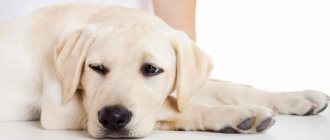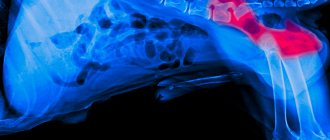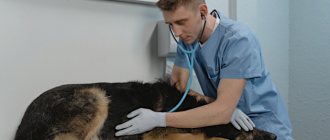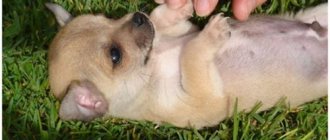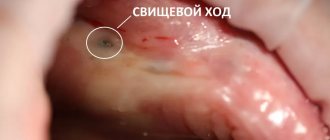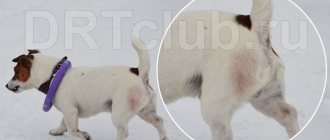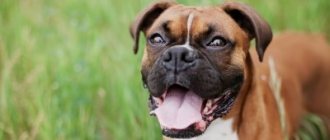Deterioration in gait, joint pain and lameness are the most common consequences of the development of a disease such as arthrosis in dogs. Just like humans, dogs can suffer from arthrosis quite often. Some breeds are more predisposed to it. There is a certain influence of the weight of the animal: in representatives of large breeds, arthrosis is diagnosed more often due to the increased mechanical load on the joints. Treatment will be more successful the sooner the first symptoms are identified and exposure begins. Let's figure out what the causes of this disease in dogs are, how it manifests itself and what treatment measures are most effective.
Why do dogs develop arthrosis?
Breeders often confuse diseases such as arthritis and arthrosis. This is quite natural, since they have common features, but there are also differences.
Arthritis is an easily diagnosed primary inflammatory disease, often developing against the background of previous injuries and bruises, with pronounced symptoms: swelling and loud crunching of the joints, severe pain, fever. As a rule, does not occur in young dogs under 2 years of age. If you seek medical help in time, the treatment is successful and the disease does not cause complications.
The reasons for the development of arthrosis can be:
- untreated arthritis;
- old age of the dog;
- excessive loads;
- heavy weight of the animal;
- injuries, including old ones;
- hip dysplasia.
Dysplasia is a genetic disease characterized by abnormal development of joints. Practice shows that representatives of large breeds suffer from this disease more often than small dogs, although it also occurs among miniature animals.
Diagnosis and treatment of arthrosis in dogs is much more difficult than arthritis.
Frequently asked questions about the disease
What is the difference between infectious and reactive arthritis?
An infectious inflammatory process develops when an infection enters a joint, and a reactive inflammatory process develops against the background of some kind of general infection in the absence of a pathogen in the joint cavity. Read more about reactive arthritis in this article.
Which doctor treats you?
Nonspecific infectious processes - a surgeon or traumatologist, specific ones - a surgeon and another specialist - an infectious disease specialist, a dermatovenerologist, a phthisiatrician. When transitioning to a chronic course, a rheumatologist.
What is the prognosis for treatment of infectious arthritis?
Depends on the infection that caused the disease. Most acute arthritis ends in recovery. The outcome of specific infections depends on the course of the underlying disease: viral arthritis ends in complete recovery, while tuberculosis arthritis does not always have a favorable outcome.
Infectious arthritis can be severe with unpredictable consequences. Therefore, it is very important to treat it promptly and correctly. They know how to do this.
Bibliography:
- Belov B. S. // Bacterial (septic) arthritis and infection of the prosthetic joint: modern aspects. — [b.m.]: Modern rheumatology., 2010.
- Parvizi J Jacovides C, Antoci V, et all, // Diagnosis of periprosthetic joint infection:. — [b.m.]: J Bone Joint Surg AM, 2012..
- Isaacs J. Oxford textbook of rheumatology. – Oxford University Press, 2013.
- Slobodin G. et al. Acute sacroiliitis //Clinical rheumatology. – 2016. – T. 35. – No. 4. – pp. 851-856.
Themes
Arthritis, Joints, Pain, Treatment without surgery Date of publication: 03/04/2021 Date of update: 03/15/2021
Reader rating
Rating: 5 / 5 (2)
Types of arthrosis and how dangerous the disease is for dogs
There are two types of arthrosis of the knee joint - primary and secondary.
The first type develops in aging dogs: the older the animal is, the greater the likelihood of developing this disease. An organism subject to the aging process is characterized by thinning of articular cartilage, a decrease in calcium content in the bones, and deterioration of blood circulation. This is enough for an old dog to develop primary arthrosis; no additional factors are required.
The second type of disease develops against the background of deposition of calcium salts, erosion and thinning of articular cartilage, and chronic arthritis.
What happens in the body of a dog that has arthrosis? The animal exhibits disturbances in trophic regulation and destructive changes in the articular components.
- How to treat arthrosis of the foot at home: folk remedies and medications, video
Causes of pathology
The most common causes of pathology include:
- hormonal changes that occur due to aging and pregnancy;
- with significant weight;
- in the presence of a hereditary tendency;
- after injuries, dislocations, sprains.
The listed reasons are primary. Poor blood supply to the joint capsule and lack of calcium in the animal’s diet, especially at a young age, are considered secondary. Inflammatory processes in tissues and joints (for example, arthritis) provoke a deterioration in the general condition of the joint capsule, which can also become the starting point for the occurrence and progression of arthrosis.
Signs of arthrosis in four-legged pets
Arthrosis in dogs, as mentioned earlier, is quite difficult to diagnose. At an early stage, this can only be done on the basis of an x-ray, of course, if the animal regularly undergoes medical examination by a veterinarian. Experts recommend doing this several times a year, especially if the dog is elderly. X-rays may show small bone growths located along the edge of the joint.
The general symptoms of arthrosis are approximately the same as those of arthritis:
- joint pain;
- swelling;
- lameness;
- loud, distinct crunching sound while driving;
- inactivity of the animal due to pain when walking.
At the second stage of arthrosis, a weakening of muscle tone occurs. You may notice that the sick dog moves from paw to paw, and a strong crunching of the joints is heard. This occurs due to the fact that the joint space narrows, and layers are formed on the bones at the joints, which have signs of osteosclerosis and osteoporosis.
With advanced arthrosis, joint deformation and bone osteoporosis are often observed. In this case, the animal at rest constantly stretches its limbs. A blood test performed at this stage will show that the content of elements such as carotene, phosphorus, and calcium in the body in general and in the bones in particular is greatly underestimated.
Classification
The origin and symptoms of infectious arthritis of different clinical forms have both similarities and differences. Let's look at the most common forms.
Acute purulent
Acute purulent arthritis of the knee joint
This form of the disease develops when a pyogenic infection (Pseudomonas aeruginosa, staphylococci, streptococci, etc.) gets into the joint. Infection can be primary in wounds and secondary - when infection spreads from surrounding tissues or distant foci of infection. People suffering from rheumatoid arthritis, especially women, are at risk.
The disease begins acutely and progresses severely. Fever, headache, chills appear. The affected joint swells and the skin over it turns red. The pain is so severe that the patient cannot move the limb and tries to give it a position that causes the least pain.
Without timely assistance, the articular surfaces quickly collapse, limiting the mobility of the limb. With adequate treatment, complete recovery occurs.
Septic
It develops against the background of already existing sepsis - a generalized infectious process. The infection enters the joint cavity through the hematogenous route - through the bloodstream. The disease can occur in the form of:
- bacterial-metastatic form with symptoms of acute purulent arthritis
- the patient’s condition can be extremely severe; the prognosis of the disease depends on timely treatment; - toxic-allergic form
- the course is not always acute, often occurs subacutely with multiple lesions of the joints of a migrating (alternating) nature; the process is non-purulent in nature and ends with recovery against the background of cure of sepsis.
Tuberculous
Arthritis in this case also occurs in the form of bacterial-metastatic and toxic-allergic forms. In the first case, the spine and large joints of the limbs are mainly affected, and the disease is called osteoarticular tuberculosis. It initially proceeds chronically with increasing pain during movement and general malaise. The main changes are visible on x-rays in the form of damage to the joint bone tissue from the appearance of a spot with loss of calcium in the bone to bone destruction. If left untreated, it leads to disability.
The toxic-allergic form, first described by Ponce at the beginning of the 20th century, is very similar to rheumatoid arthritis with a chronic onset and damage to the small joints of the hands and feet. Their destruction and disability are also possible. Damage to large joints sometimes occurs without consequences and resolves with anti-tuberculosis therapy.
Chondroprotectors: what are they, how to choose, how effective are they?
Joint pain at rest
Gonorrheal
Damage to joints by gonococcal infection can have bacterial-metastatic and toxic-allergic forms. In both cases, large joints are affected, most often one knee (ankle, wrist). The disease is acute, with high fever, intoxication and severe joint pain. The knee swells, turns red, and is impossible to touch because of the pain.
With timely treatment, the disease has a favorable outcome. If left untreated, complete immobility of the limb quickly sets in.
Borreliosis
Borreliosis or Lyme disease is an infection caused by spiral-shaped bacteria called Borrelia spirochetes. It is transmitted by ticks and occurs in a succession of stages:
- 1-2 weeks after a tick bite, an increase in body temperature, intoxication, muscle stiffness and the appearance of redness on the body at the site of the tick bite - erythema, surrounded by concentric rings, spreading to large areas of the body. With timely administration of antibacterial therapy, the disease can end at this stage.
- It develops 1–3 months after the onset of the disease and manifests itself in the form of lesions of the nervous system (meningitis, neuritis with acute pain) and the heart (heart block, myocarditis, etc.).
- Joint damage begins six months (sometimes 2 years) after the onset of the disease in genetically predisposed people and occurs in the form of severe joint pain, a benign recurrent inflammatory process that occurs as an infectious-allergic arthritis with asymmetric damage to 1 - 2 joints (most often the knee) and ending after a few years with recovery in most patients. But in some patients the disease can become chronic with gradual impairment of limb function.
The initial stage of borreliosis is erythema migrans and stage 3 is chronic arthritis of the knee
Viral
Develops against the background of various viral diseases:
- Parvovirus infection caused by parvovirus B19
- the disease occurs with intoxication, fever, skin manifestations in the form of red spots, papules raised above the skin and pinpoint subcutaneous hemorrhages. At the same time, symmetrical damage to the joints occurs. Small joints of the hand, wrist, elbow, knee, and ankle joints may be involved. Symptoms are similar to rheumatoid lesions, but last from 3 months to a year and have a favorable outcome. - Rubella
– arthritis develops more often in adult women against the background of existing symptoms of rubella or before their appearance. Such lesions are rare in children. The periarticular tissues swell, turn red, and severe pain appears, disrupting joint function. The lesion is asymmetrical with the involvement of small joints of the hand, wrist, knee, and elbow joints. Arthritis lasts two to three weeks, after which complete recovery occurs. - Viral hepatitis B and C
- arthritis develops quite often, but has a benign course and ends with complete recovery. Small joints of the hand, elbows, ankles and, less commonly, other joints are affected. Inflammation in the joints usually begins before the appearance of jaundice and ends during its peak.
Arthrosis in dogs: what treatment is prescribed?
The first thing to do is contact your veterinarian. Dog owners should understand that such a serious disease cannot be cured at home. Only a specialist, based on an examination of the animal, a clinical picture and an x-ray, will make a diagnosis and prescribe appropriate treatment that will make the pet’s life easier.
Unfortunately, many either postpone a visit to a veterinary hospital, or simply do not pay attention to alarming symptoms for a long time and attribute lameness to injuries, so doctors have to eliminate not only the disease itself, but also its consequences.
If a dog is diagnosed with arthrosis, the owner must be prepared for the fact that the treatment will be long, complex and include not only medication and physical therapy, but also compliance with a special regime. Therefore, first of all, you need to provide your pet with complete rest, provide him with a comfortable soft bedding on which he will sleep and rest comfortably.
All physical activity during the treatment period is kept to a minimum. You can and should walk your dog, otherwise it may experience muscle atrophy, and a strong muscle corset is extremely important for an animal. However, the walking time should not be exceeded. Excessive loads on the joint can lead to complete wear of the cartilage, and this, in turn, will increase the crunching and pain. A strong muscle corset is extremely important for an animal.
In dogs, treatment is usually symptomatic and depends on the form of the disease. Anti-inflammatory non-steroidal drugs (NSAIDs) are indicated. They effectively relieve inflammation and pain. Used as intra-articular injections or intramuscular injections. Such drugs include:
- What is arthrosis of the foot and how to treat it?
- Voltaren (diclofenac);
- Brufen; (ibuprofen);
- quadrisol-5;
- gamavit;
- vedaprofen.
At the initial stage of arthrosis, you can lubricate the swollen joint with an alcohol solution of iodine, apply cold lotions with salt and alternate them with warming compresses of ozokerite and paraffin; make wraps from decoctions of medicinal plants. However, these measures are aimed only at eliminating symptoms and cannot be a substitute for full treatment.
Infrared radiation from special lamps is very effective for relieving edema and swelling.
The dog's feeding must be adjusted. The menu should be expanded to include fresh meat, dairy products, vegetables, and always grated carrots. Boiled bones are very useful so that the dog can gnaw on tendons and cartilage, as well as jellied meat, aspic, which are, in fact, homemade chondroprotectors.
The animal must receive all the necessary vitamins and minerals aimed at rapid tissue growth, replenishing cartilage and synovial fluid.
In addition, chondroprotectors are shown that:
- promote rapid restoration of articular cartilage,
- make cartilage resistant to physical stress,
- increase resistance to various types of infections.
If drug treatment does not help or arthrosis of the knee joint becomes chronic, surgical methods such as arthrodesis, osteotomy, and prosthetics (in some cases) are used.
Diet
Diet is one of the most important factors in the treatment of arthrosis. If you are overweight, you need to reduce it to reduce the stress on your joints. In this case, a balanced diet with a calorie deficit is prescribed. Regardless of body mass index, doctors recommend completely avoiding:
- fast carbohydrates (sugar, desserts, flour);
- alcoholic drinks;
- spices;
- legumes;
- strong tea and coffee;
- excessively fatty and spicy foods.
Canned food and offal are not excluded, but are significantly limited, as is salt. An ideal diet for osteoarthritis includes:
- lean meats;
- fish and seafood;
- eggs;
- dairy products;
- flaxseed and olive vegetable oils;
- vegetables and fruits, a large amount of greens;
- cereals in moderation, durum wheat pasta;
- products with a high content of collagen (jellied meat, jellied meat, jelly).
Preventive measures against the development of arthrosis in dogs
So that the dog does not have to be treated for a long time for a dangerous disease, certain measures should be taken to prevent arthrosis from the very first days of the puppy’s appearance in the house.
Such measures include:
- Reasonable physical activity. Active games outside, walks should last more than three hours. You need to walk your pet more often.
- Balanced feeding, including all necessary vitamins and microelements. The food must be enriched with proteins and carbohydrates to prevent tissue weakening.
- Monitor your dog's weight to minimize the risk of obesity to avoid placing excessive stress on the skeleton.
- Try to avoid injury. Slippery laminate, parquet or linoleum often lead to injury to the dog, so it is advisable to cover the floor in the room with carpet.
- Regular examination of the animal by a veterinarian.
- Provide the pet with soft bedding, and the greater the dog’s weight, the softer it should be.
Remember that any disease is easier to prevent than to treat.
General clinical recommendations
Persons who have had acute infectious arthritis or suffer from chronic infectious arthritis must:
- lead an active healthy lifestyle, quit smoking and alcohol abuse;
- eat properly and fully;
- exclude heavy physical activity and injuries;
- engage in therapeutic exercises, swimming and feasible sports;
- treat infections promptly;
- carry out doctor's orders; in the chronic course of the disease, conduct courses of anti-relapse treatment.
Prevention
Infectious arthritis can be prevented by doing hardening, sports without heavy physical activity, eating right and treating all infections in a timely manner.
We combine proven techniques of the East and innovative methods of Western medicine.
Read more about our unique method of treating arthritis
What is arthrosis in dogs
The disease in question is often confused with arthritis. Despite the similarity in sound and the similarity of some signs of pathology, arthrosis has a number of fundamental differences from arthritis.
With arthrosis, premature wear of the cartilage tissue, which is located inside the joint capsule, is noted. The period of development of the pathology is long, therefore it is detected more often in advanced stages. In such a situation, arthrosis of the joint requires longer recovery and rehabilitation. Therefore, every dog owner should promptly pay attention to disturbing symptoms in his pet and carry out the necessary examinations: this will allow him to quickly restore health and prevent complete destruction of the joints .
- What is arthrosis of the foot - symptoms and treatment, causes, how to treat foot disease
What happens with arthrosis
The development of arthrosis is characterized by damage to cartilage tissue cells in a dog. Gradually, in the absence of influence, the negative manifestations intensify, capturing more and more new areas and parts of the joint capsule. As it progresses, both bone tissue and ligaments can be damaged. This entails serious disturbances in the dog’s motor system and can cause lameness and loss of the ability to move normally.
Typically, symptoms of arthrosis in dogs occur when the joints wear out at a certain age. However, they can be observed in case of excessive mobility of the animal during life, with a hereditary tendency to damage joints and ligaments, as well as with significant body weight.
There are two types of arthrosis in dogs. The first is characterized by its occurrence as a result of birth trauma, when congenital damage to the cartilage tissue in the joint is noted. With dysplasia, which also refers to birth injuries, the load on the joint is incorrectly distributed. And this causes uneven wear of cartilage tissue.
Genetic predisposition refers to the first type of disease. This may be a disorder in the chromosomal composition, as a result of which the process of synthesis of cartilage tissue in the body changes, weakness of the ligamentous and tendon apparatus, pathological changes in the condition of the blood vessels that feed the joint capsule.
The following conditions lead to the second type of arthrosis in dogs:
- dislocations, prolapse of the kneecap, sprain and rupture of ligaments;
- hormonal changes. They are caused by aging of the body, pregnancy;
- inflammatory processes in the joints;
- pathologies of the veins, as a result of which the blood supply to the cells and tissues of the joints is disrupted.
How dangerous is the condition?
The unnoticed development of arthrosis is very dangerous for a pet. Developing gradually, arthrosis is able to “capture” an increasing amount of tissue.
The initial stage of the pathology is characterized by a violation of the integrity of the cartilage tissue of the joint. Gradually, more and more destruction occurs, and with complete thinning, mechanical friction of the bones is noted during the operation of the joint. Most often, this problem occurs in representatives of large breeds.
Lack of exposure in the early stages is dangerous due to the following conditions:
- the occurrence of painful sensations when the animal moves;
- the dog’s gait and its stability change;
- In places of unprotected contact of bone tissue, cracks, grooves and depressions appear. This disrupts the natural structure of the joint capsule and its destruction;
- lameness begins;
- In the later stages of the disease, the dog may lose the ability to move.
The disease can occur gradually, moving from one stage of development to another. However, there is also the manifestation of arthrosis in dogs due to injury, large body weight, and also heredity.
Stages of the disease
According to recent studies, arthrosis occurs due to disturbances in the blood supply to the joint. As a result, there is a pathological change in the condition of bone and cartilage tissue, an imbalance in the cells of cartilage and ligaments.
As you know, arthrosis is a disease with a long course. There are several stages in this disease:
- The first stage is characterized by the appearance of microcracks on the surface of the cartilage tissue. Pathological changes still appear at the cellular level; the pathology has no external manifestations. In this case, there is a significant decrease in the amount of moisture in the cartilage of the joint. And since cartilage tissue contains a large amount of water (60-80%), even a slight loss of it has a noticeable effect on the cartilage.
- At the second stage, the formed grooves in the cartilage tissue deepen, and its separation intensifies. The animal begins to experience pain when moving, externally this can be observed in the form of changes in gait, instability of the dog. The pressure on the bone tissue of the joint increases, and friction occurs when loaded.
- With the transition of the disease to the third stage, a significant change in its behavior occurs: the animal, due to painful sensations when moving, stops actively moving, becomes slower and less stable. The bones begin to rub against each other because the cartilage tissue is completely depleted. Spikes-growths form on it, which cause pain when working the joints. Subsequent progression of the disease leads to the entry of cartilage fragments into the interarticular space and provokes the development of the inflammatory process. If the owner has not taken any therapeutic measures by this time, then there is a high probability of complete immobility of the affected joint - ankylosis.
The joint damage in question has a specific localization. The joints most often affected by arthrosis are the knees, shoulder joints, joints of the hind limbs, and elbow joint. Arthrosis of the hip joint is also diagnosed.
Diagnostics
The main task of diagnosis is to identify the causative agent of infection that is “culpable” in the development of infectious arthritis. The degree of destruction of the joint must also be determined. The following studies are being carried out:
- Laboratory:
- general blood test - signs of inflammation; in toxic-allergic forms of arthritis – increased levels of eosinophils;
- blood biochemistry – general disorders characteristic of a particular infection;
- examination of synovial fluid - the nature of inflammation;
- immunological studies - antibodies to various infectious agents;
- PCR and microbiological studies (inoculation of biological media on nutrient media) – identification of infectious agents;
- histological studies - a piece of synovial membrane tissue taken by biopsy is examined under a microscope - identifying changes characteristic of a specific infection.
- Instrumental:
- Ultrasound – reveals the presence of exudate in the joint cavity and damage to soft tissues;
- radiography - reveals the degree of damage to the bone tissue of the joints;
- computed tomography (CT) – detailing bone destruction;
- diagnostic arthroscopy – examination of the condition of the inner surface of the synovial membrane with the possibility of taking exudate or a piece of tissue for examination.
Symptoms
Manifestations of pathology, as noted above, are changes in the dog’s gait, loss of stability when moving, and pain with increased activity. In advanced stages, the animal moves less, complains of pain, becomes lethargic, and appetite worsens.
Manifestations depend on the stage of the disease, the age of the animal, and the degree of its activity. The pet with difficulty, as if without desire, stands on all four paws. He ceases to be interested in outdoor games, favorite toys, even food.
Diagnostics
The process of diagnosing arthrosis begins with an external examination of the animal and an analysis of its behavior and activity. The presence of the listed main symptoms of the disease in combination with changes in behavior (decreased usual activity, the dog lies down more, does not show interest in communicating with the owner and relatives) should be the reason for contacting a veterinarian.
The doctor will conduct a number of diagnostic procedures and necessary tests. Only after this is a final diagnosis made and the necessary treatment prescribed.
Why Previcox?
- Designed specifically for dogs
- Determined in blood plasma after 30 minutes 3
- Apply once a day
- Tablets with an attractive taste
- Tablets can be divided
- Doses adapted to dog size
Be sure to discuss all your options with your veterinarian. After all, pain should not interfere with your pet’s life or bring discomfort to you.
- SA Johnston Osteoarthritis. Joint anatomy, physiology, and pathobiology. Vet Clin North Am Small Anim Pract.
- KE Joubert 1 The effects of firocoxib (Previcox) in geriatric dogs over a period of 90 days
- Borer-Weir K. Analgesia. In: Clarke KW, Trim CM, Hall LW, eds. Veterinary Anaesthesia. 11th ed. Philadelphia, PA: W. B. Saunders; 2014:101–133
Treatment of arthrosis in dogs
To obtain positive dynamics when diagnosing arthrosis in a dog, you must strictly adhere to the veterinarian’s recommendations. This will bring the period of remission closer, eliminate pain when the pet moves, improve its mood and prevent the disease from progressing to a later stage.
First aid
The main condition for providing first aid to an animal suffering from arthrosis is the elimination of severe discomfort and pain when moving. For this purpose, it is necessary to provide peace and comfort to the pet. It is better to prefer short and calm walks, without sudden movements or active games. This will prevent further injury to the affected joints.
However, movement cannot be completely ruled out. Indeed, in this case, there is a high probability of muscle atrophy. A strong muscle corset will support the animal and remove most of the load from the affected joint.
It is also recommended to use a pain reliever. The veterinarian usually prescribes the optimal type of such drug during diagnosis. Today, non-steroidal anti-inflammatory drugs are most often recommended for use. They can be either in tablet form or in the form of injections. For quick pain relief, it is better to use injections.
Basic treatment measures
To understand how to treat arthrosis in a dog, you should consult your doctor. Only he will prescribe the most effective treatment regimen, taking into account the characteristics of the animal: its activity, age, existing diseases or pathologies.
The following complex effect will allow you to quickly restore the animal’s condition, eliminate pain during movement and prevent the progression of the disease:
- use of chondroprotectors. These products restore cartilage tissue well and stop its destruction;
- use of anti-inflammatory drugs;
- immunostimulants. With their help, the normal functioning of the immune system is restored, the body fights existing inflammatory phenomena in the joints;
- vitamin complexes and mineral supplements.
To relieve pain, especially severe pain, drugs with an analgesic effect and blockades are used. Particularly severe pain and the inability to move independently are eliminated with an injection directly into the affected joint: this is how the medicine acts as quickly as possible. This procedure is painful, but highly effective. To support the joint, special devices can be used that are attached to the dog’s body and relieve some of the load on the affected area (for example, knee pads).
Medications
Today, the following medications are considered effective in detecting arthrosis in dogs:
- chondroprotectors Chondrocaine, Glucosamine, Artroglycan;
- immunostimulants, for example, Gamavit;
- tranquilizers for pain relief - Novocain, Voltaren;
- antimicrobial drugs – ciprofloxacin (acts on bacteria that provoke inflammation, inhibits their activity), diprospan.
Traditional medicine
Time-tested traditional medicine will help speed up the animal’s healing process. However, it is recommended to coordinate their use with the treating veterinarian.
Compresses soothe and relieve swelling in the affected joint. Warming compresses increase blood flow and support the necessary nutrition of joint tissues. If arthrosis is diagnosed, your pet can be given compresses from cinquefoil tincture, and mild pain will be relieved by a compress using a fresh cabbage leaf.
Gentle massage of the affected area also reduces pain and stimulates the activation of blood supply to tissues. The basic movements of the massage should be shown by a doctor. The main condition for benefit for joint arthrosis in dogs is the regularity of the procedure. In some cases, there is even an increase in the pet’s motor activity after a massage.
It is recommended to include aspic or jellied meat in the diet of a sick dog. These products are natural and natural chondroprotectors that perfectly support and nourish the joints and can be a preventive measure for diseases of the joint tissues.
Rules for caring for a sick dog
The owner of an animal who has been diagnosed with arthrosis should know the basic rules of care. They look like this:
- Reduce the amount of time your animal walks. Walk your dog on a leash at a pace that is comfortable for him.
- When walking in cold or wet weather, you should carefully dress your animal. The dog should not get wet or freeze.
- Provide her with a warm and comfortable place to rest. The bed should be comfortable, of sufficient size, and not too thin.
- Anticipate all possible possibilities for your dog to get injured.
Create a diet rich in nutrients, vitamins and minerals, primarily calcium.
Therapy
The main drugs used in modern veterinary medicine for the treatment of arthrosis belong to the group of anti-inflammatory non-steroids. These veterinary medications can be prescribed in tablet form or by injection - in any case, they are taken in a course as prescribed by the doctor.
Self-medication of arthritis is not only pointless, but can also harm the animal, since drugs are prescribed individually. Typically, non-steroidal anti-inflammatory drugs are combined with the use of chondroprotectors that restore cartilage tissue. The most popular include the following chondrotherapy drugs: “Artroglycan” , “Chondrocaine”, “Stride Plus”, “Glucosamine”, “Kinosil” and others.
"Glucosamine" from the brand "8 in1 Excel"
Arthrosis therapy may also include:
- immunostimulants (for example, Gamavit);
- vitamins and minerals, in particular magnesium and calcium, phosphorus, vitamins B, A, D3;
- tranquilizers, pain blockades (Novocain, Voltaren and the like).
"Gamavit"
In some cases, injections are made directly into the affected joints, which is an unpleasant but effective procedure. Surgical interventions (for example, joint arthroplasty) are also allowed. It is given to young animals and at the initial stage of the disease, when the symptoms of the disease are not very pronounced. In older animals, as well as in cases of severe joint destruction, surgery is not effective.
Determining the best treatment plan is the responsibility of the veterinarian
As for older dogs, it is impossible to completely cure arthrosis in them. The owner must make efforts for supportive therapy, as well as ensure a calm and comfortable existence for the old pet. To do this, you need to arrange a soft and warm bed where the dog can take a comfortable position. It is advisable to place the dog on the floor so that it does not have difficulty climbing onto a sofa or chair, and, accordingly, jumping down.
You need to make sure your dog is comfortable on walks. Activity should be reduced to the maximum, walking with the animal on a leash at a pace that is comfortable for it. In wet or cold weather, walks should be reduced to a minimum, and the animal should be dressed in warm clothes, for example, a special overall.
You need to make sure your pet doesn’t get wet or cold.
Gentle massage of the affected joint shows good effectiveness; sometimes the use of warming or analgesic ointments and tinctures is recommended. Due to the massage, blood flow improves, pain is reduced, and often after the session the animal begins to move much better and more confidently.
A veterinarian should show you the correct massage technique for a dog with arthrosis. Movements should be confident, but soft, so as not to cause discomfort to the animal. The effectiveness of this procedure will only appear with a certain regularity - the dog needs to be massaged daily, most likely in the morning and evening.
Massage improves blood flow and relieves pain
Prevention of arthrosis in dogs
To prevent the development of joint damage in your pet at home, it is necessary to provide adequate nutrition. It must be balanced and include all the substances the pet’s body needs to maintain healthy joints and cartilage tissue. Avoid injury to the animal and protect its health.
Attentive attention to the dog’s condition will allow you to detect health problems in time and take timely measures. Regular examinations by a veterinarian and complete cure of diseases help maintain immunity at the required level. This means it will prevent the development and progression of arthrosis.
Summarizing
Arthrosis is a disease that a dog owner can prevent, rather than helplessly watch its development and the pet’s suffering. There are simple preventive measures, in particular, preparing a balanced diet and an optimal exercise regimen that does not allow the dog to overwork, but also prevents obesity. It is also important to ensure that the dog does not become hypothermic or injured, which is especially common in hunting dogs and animals participating in sporting competitions.
Owner stories
An analysis of the stories of dog owners shows that the earlier the disease was identified and the more thoughtful treatment regimens were drawn up, the faster and more likely the animal returns to its normal state and the main signs of arthrosis are eliminated.
Peter, owner of a German shepherd: “My Jack is already 9 years old. I began to notice that on walks he did not show the usual activity, but at home he lay down more. Got him checked by the vet and they diagnosed him with hip arthritis. A treatment system was prescribed, which included anti-inflammatory treatment with diprospan injections. This medicine quickly eliminated the pain, and maintenance therapy in the form of taking Gamavit and including beef aspic in the menu returned my Jack to his former cheerfulness.”
Elena from Novosibirsk also talks about the need to visit a veterinarian even with minor deviations in the dog’s behavior. Her toy terrier Clichy was diagnosed with arthrosis of the shoulder joint. The doctor advised using Gamavit to maintain the body, and ciprofloxacin to eliminate the inflammatory process in the joint. Since the dog is still young (she is 2 years old), the disease was detected in the initial stage. Following all the doctor’s instructions made it possible to quickly eliminate the baby’s stiffness in movement and return her to activity.
Tatyana from Minsk, the owner of the American Staffordshire Terrier King, who is 12 years old, is forced to completely change his diet and constantly support his completely worn-out hip joint. Due to old age and heavy weight, the joint experiences constant stress. Soreness is expressed in the dog’s refusal to take long walks; the dog constantly lies down, not responding to his favorite toys. However, after carrying out therapeutic manipulations in combination with such traditional medicine as a compress on a sore joint with cinquefoil decoction, a relaxing massage, King again became more cheerful and even began to move more. However, his age requires constant monitoring by a doctor and taking supportive medications: these are chondroprotectors and vitamins, as well as mineral complexes.
Attention to your pet, timely detection and treatment of existing diseases and supportive nutrition will ensure its activity and longevity. Be attentive to your four-legged friends, because we are the ones responsible for their fate and health!
Due to natural laws and other factors, wild dogs do not live to a very old age. The lifespan of pets is 10-20 years, but with age they develop diseases. Let's consider such a pathology as arthrosis in dogs, its symptoms, treatment and necessary medications. This disease is age-related. It leads to improper joint function and pain during movement.
The disease is characterized by its slow progression. A pet may suffer from it for several years, but the symptoms will not be noticeable. As a result, the doctor finds it in an advanced stage. Arthrosis has almost no cure, so it is important to study the puppy’s pedigree before purchasing. Pathology is not a reason to refuse it, you just need to be aware of the peculiarities of caring for a dog prone to illness.
Approach to treating the disease in our clinic
Medical doctors in Moscow have developed their own approach to the treatment of infectious arthritis. It includes:
- thorough identification of the causes (infectious factor) of the disease;
- suppression of infection using modern medicinal methods developed in the most advanced clinics in the world;
- restoration of joint function using modern medicinal and non-medicinal methods, as well as using traditional methods of treatment of ancient Chinese medicine, which considers the human body as a whole.
As a result of the complex treatment, our patients forget about pain and lead their usual lifestyle. To prevent exacerbations, our clinic conducts courses of anti-relapse treatment.
What is arthrosis in a dog and how does it differ from arthritis?
Many owners are aware of the danger of developing arthrosis in their pets. But people often confuse pathology with arthritis. These diseases are similar, but the symptoms and treatments are different. Arthritis is diagnosed quite simply and has noticeable symptoms. For example, tumors in the joints, severe pain, loud crunching sounds while walking, fever.
An experienced specialist can easily cope with the treatment of this disease. Arthritis is a very common primary pathology and the risk that an older dog will have joint pain is high. Arthrosis appears if the arthritis is very advanced or for other reasons. It is much more difficult to identify and get rid of. The problem usually appears in pets as they get older.
The pathology does not occur in an acute form, only in a chronic form. First, the animal develops a disturbance in trophic regulation, metabolic disruptions, and almost irreversible destructive changes in the functioning of the joints occur.
Arthrosis is divided into primary and secondary. It usually develops in the elbow, hip, knee and hock joints. The primary form appears due to age-related changes in the pet’s body. The older he is, the more likely the risk of pathology. The functioning of the vascular circulatory system becomes worse, the cartilage tissue becomes thinner. There is not enough calcium in the dog's bones. It is important to consider that primary arthrosis does not appear from serious bruises or injuries. The secondary type is formed due to the accumulation of calcium in the joints, thinning of cartilage tissue, erosion, dysplasia or advanced arthritis.
Osteoarthritis affects the cartilage, which slowly breaks down, causing open areas to form on the bones. There is a violation of the main task of cartilage tissue - it protects bones less well from contact with each other and does not ensure unhindered movement.
Because of this, the bones slowly collapse, cracks, depressions, and small grooves appear in the area of their contact. Such negative changes affect the shape of the glenoid cavity. There is a risk that the cartilage, ligaments and tendons will not heal properly. This will provide other troubles. Articular mice with the development of arthrosis in dogs are a fragment freely located in the joint space. Pathology requires surgical intervention.
Localization of infectious arthritis
In case of infectious joint damage, the localization of the pathological process depends on the characteristics of the infection and its clinical form. In acute purulent arthritis, these are mainly large joints - knee, ankle, elbow. Small joints of the hand and foot are affected in the toxic-allergic form of tuberculosis and some viral arthritis.
Asymmetrical damage to one or two large joints is characteristic of borreliosis; most often with this infection, the knee joints are involved in the process.
Crunching in joints - when to worry
Intra-articular injections of hyaluronic acid
How does it manifest itself in pets?
Pathology is expressed differently depending on the following factors:
- Age category.
- Concomitant diseases.
- Number of damaged joints.
- Stage of arthrosis.
Owners usually begin to notice that the dog is limping. But the signs may vary. For example, when the joints of the hind limbs are affected, the function of the pelvic girdle is impaired. The dog moves unsteadily and his gait becomes unsteady. It is difficult for him to get up, fatigue overcomes quickly.
The degree of lameness is influenced not only by how affected the joints are, but also by the structure of the pet and the characteristics of the nervous system. There are dogs that have a high pain threshold, and lameness is noticed in the later stages of the disease. The veterinarian and owner should remember this when treating. Then the absence of lameness will not be a reason to stop therapeutic measures.
The severity of symptoms varies throughout the day. For example, the main symptom of the disease is initial lameness, which can be seen after sleep. Usually during the morning awakening, because the dog had been at rest for a long time. It is difficult for the pet to get up, the lameness will be severe until the functional ability of the joint is normalized. Afterwards the symptom will become weaker or disappear.
Main symptoms of the disease
Let's look at how different types of disease manifest themselves:
- Arthrosis of the knee joint. The pet is limping, and a “crouched” position is noticed. Doesn't want to run, feels pain when jumping.
- Shoulder joint. The pet's steps become shorter, and he shifts from paw to paw in place. If he lies down, he gets up with difficulty.
- Hind limbs. The dog rises carefully and for a long time after waking up, first moving on its hind legs, crouching slightly.
- Hip joint. After sleep, the signs are more visible. The pet carefully stands up, walks in small steps, removing the load from the pelvis, transferring it to the front legs. In neglected form, he pulls his limbs behind him, after which he begins to walk more confidently.
General symptoms of the disease:
- pain in the joints;
- loud crunching sound when moving;
- decreased pet activity due to pain when moving;
- lameness;
- swelling.
At the second stage of the pathology, muscle tone becomes weaker. The owner discovers that the dog is trampling with its paws, a characteristic loud crunch sounds. The reason for this is the narrowing of the joint space; stratification appears on the bones at the joint sites with signs of osteoporosis and osteosclerosis.
If the disease is in an advanced form, the joints become deformed and bone osteoporosis occurs. When the pet lies down, it stretches out its paws. When performing a blood test, it is clear that the content of calcium, phosphorus and carotene is very low.
Clinical picture of joint pathologies
Despite the close relationship, arthrosis and arthritis are two different diseases. They have similar symptoms, but the causes and course are different. Arthritis in dogs and horses is an infectious or non-infectious inflammation of one or more joints. While bacteria are the trigger for the infectious form, the non-infectious form is based on the inflammatory responses of the immune system. With arthrosis, a degenerative chronic change in the joint occurs, associated with pain and progressive limitation of mobility of the affected area. The disease is not inflammatory or infectious in nature. This is a consequence of the constant degradation of articular cartilage beyond normal levels. The disease progresses slowly, is usually asymptomatic and does not appear until years later.
Treatment of the disease
At the first signs of illness, you should contact a veterinary clinic. Owners need to know that this serious pathology cannot be treated independently at home. Only the doctor, after examination, studying the clinical picture and x-rays, makes a diagnosis and offers therapeutic methods to alleviate the animal’s condition.
The treatment will be difficult and lengthy. Not only will medications and procedures such as laser be required, but also a special regimen. The pet needs peace, a comfortable soft bedding where he lies with pleasure. Physical activity should be administered in a minimal amount. Walking is necessary, otherwise there is a risk of muscle atrophy. The pet needs a strong muscle corset. But you shouldn't walk for very long. If the load on the joint is too intense, there is a risk of complete wear of the cartilage, which will increase pain and crunching.
Therapy is aimed at eliminating symptoms. Anti-inflammatory non-steroidal drugs are prescribed. They relieve inflammation and pain. They are used as intra-articular injections, and intramuscular injections are also used. The following medications are prescribed:
- "Voltaren."
- Vedaprofen.
- "Quadrisol-5".
- "Brufen."
- "Gamavit."
At the beginning of the disease, it is possible to treat the swollen area with an alcohol solution of iodine. Using cool compresses with salt is effective. You can use them in turn with warming lotions of paraffin and ozokerite. These options are intended only to relieve symptoms; they do not act as full-fledged therapy. If the pain is very severe, you can use the painkiller “Gelakan Fast”.
Infrared lamps are widely used to eliminate swelling and swelling. Chondroprotectors are also prescribed. They are designed for the following tasks:
- accelerated restoration of joint cartilage;
- providing cartilage with endurance for physical activity;
- increasing protection against infectious pathologies.
If drug therapy is ineffective, surgical intervention is required. Osteotomy, arthrodesis, and sometimes prosthetics are used.
Exercises for sick dogs
Light physical activity stimulates the restoration of cartilage and has a positive effect on delaying joint degeneration. It is better to coordinate them with a veterinarian, since exceeding the permitted level often leads to deterioration.
Physiotherapy is relevant for arthrosis of the hip joint, especially water exercises and swimming. Flexion and extension of the joints of diseased paws is often included in long-term therapy. The best exercise option would be slow walks on a leash. If you have a severe illness, it is recommended to stay outside for five minutes, then you can increase it by another five minutes. If lameness worsens, the time should not be extended.
Advantages of the clinic
“Health Energy” is a multidisciplinary medical center equipped in accordance with modern standards. We offer patients:
- consultations with experienced doctors;
- examination using high-quality diagnostic equipment;
- individual approach to treatment selection;
- regular monitoring and performance monitoring.
The joints of our body can withstand enormous loads, but there are situations when they need help. Don’t let arthrosis change your life, sign up for a consultation at Health Energy.
Nutrition for arthrosis for pets
Changes will need to be made to your pet's diet. The diet needs to be expanded, add fresh meat, dairy products, vegetables (especially grated carrots). It is necessary to boil the bones so that the dog can gnaw on the cartilage and tendons. Make aspic, jellied meat, because these dishes are considered homemade chondroprotectors.
It is important to provide your pet with the necessary vitamins and minerals so that tissue growth occurs faster and the synovial fluid and cartilage are nourished.
